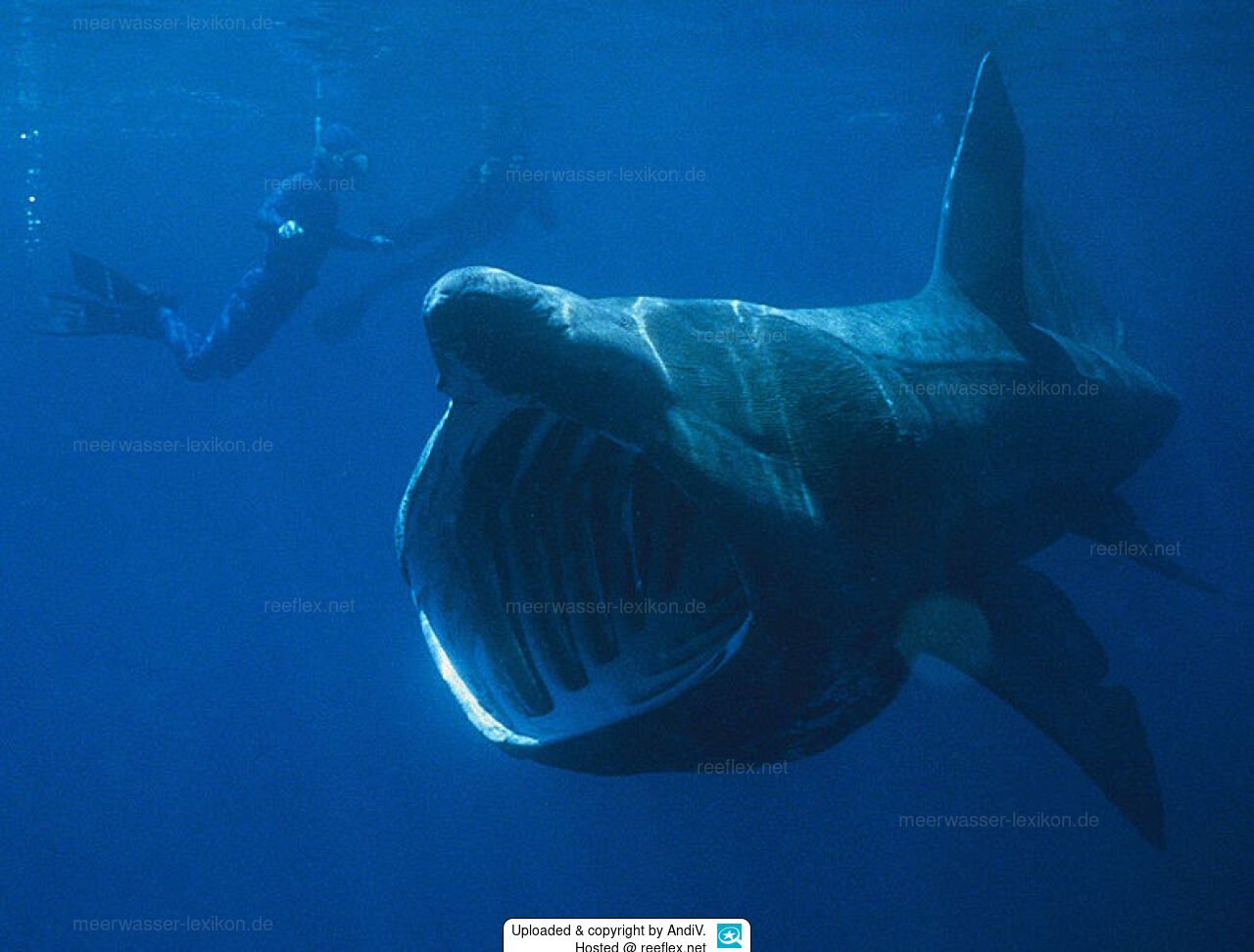Info
Cetorhinus maximus (Gunnerus, 1765)
Cetorhinus maximus, better known as the basking shark is the second largest living fish, after the whale shark, and the second of three plankton-eating sharks, the third is the megamouth shark. They are generally found in temperate waters of both the Pacific and Atlantic Oceans. The Basking Shark Cetorhinus maximus is listed as a CITES protected species.
Basking sharks are recognized by their huge sizes, conical snouts, sub-terminal mouthes, extremely large gill slits, dark bristle-like gill rakers inside the gills (present most of the year), strong caudal keels and large lunate (curved) tails. Basking sharks have numerous, small teeth. Their bodies are mottled gray/brown to slate-gray or black in color, sometimes with lighter patches on the dorsal side. The ventral side is paler, often with white patches under the snout and mouth or along the ventral side.
Synonyms:
Cetorhinus blainvillei Capello, 1869
Cetorhinus maccoyi (Barrett, 1933)
Cetorhinus maximus infanuncula Deinse & Adriani, 1953
Cetorhinus maximus normani (Siccardi, 1961)
Cetorhinus normani Siccardi, 1961
Cetorhinus rostratus (Macri, 1819)
Halsydrus maccoyi (Barrett, 1933)
Halsydrus maximus (Gunnerus, 1765)
Halsydrus pontoppidiani Neill, 1809
Hannovera aurata Van Beneden, 1871
Polyprosopus macer Couch, 1862
Scoliophis atlanticus Anonymous, 1817
Selache elephas (Le Sueur, 1822)
Selache maxima (Gunnerus, 1765)
Selache maximum (Gunnerus, 1765)
Selache maximus (Gunnerus, 1765)
Selachus pennantii Cornish, 1885
Squalis gunneri Blainville, 1816
Squalis shavianus Blainville, 1816
Squalus cetaceus Gronow, 1854
Squalus elephas Lesueur, 1822
Squalus gunnerianus Blainville, 1810
Squalus homianus Blainville, 1810
Squalus isodus Macri, 1819
Squalus maximus Gunnerus, 1765
Squalus pelegrinus Blainville, 1810
Squalus peregrinus Blainville, 1810
Squalus rashleighanus Couch, 1838
Squalus rhinoceros DeKay, 1842
Squalus rostratus Macri, 1819
Tetraoras angiova Rafinesque, 1810
Tetroras angiova Rafinesque, 1810
Tetroras maccoyi Barrett, 1933
Classification: : Biota > Animalia (Kingdom) > Chordata (Phylum) > Vertebrata (Subphylum) > Gnathostomata (Superclass) > Pisces (Superclass) > Elasmobranchii (Class) > Neoselachii (Subclass) > Selachii (Infraclass) > Galeomorphi (Superorder) > Lamniformes (Order) > Cetorhinidae (Family) > Cetorhinus (Genus) > Cetorhinus maximus (Species)
hma
Cetorhinus maximus, better known as the basking shark is the second largest living fish, after the whale shark, and the second of three plankton-eating sharks, the third is the megamouth shark. They are generally found in temperate waters of both the Pacific and Atlantic Oceans. The Basking Shark Cetorhinus maximus is listed as a CITES protected species.
Basking sharks are recognized by their huge sizes, conical snouts, sub-terminal mouthes, extremely large gill slits, dark bristle-like gill rakers inside the gills (present most of the year), strong caudal keels and large lunate (curved) tails. Basking sharks have numerous, small teeth. Their bodies are mottled gray/brown to slate-gray or black in color, sometimes with lighter patches on the dorsal side. The ventral side is paler, often with white patches under the snout and mouth or along the ventral side.
Synonyms:
Cetorhinus blainvillei Capello, 1869
Cetorhinus maccoyi (Barrett, 1933)
Cetorhinus maximus infanuncula Deinse & Adriani, 1953
Cetorhinus maximus normani (Siccardi, 1961)
Cetorhinus normani Siccardi, 1961
Cetorhinus rostratus (Macri, 1819)
Halsydrus maccoyi (Barrett, 1933)
Halsydrus maximus (Gunnerus, 1765)
Halsydrus pontoppidiani Neill, 1809
Hannovera aurata Van Beneden, 1871
Polyprosopus macer Couch, 1862
Scoliophis atlanticus Anonymous, 1817
Selache elephas (Le Sueur, 1822)
Selache maxima (Gunnerus, 1765)
Selache maximum (Gunnerus, 1765)
Selache maximus (Gunnerus, 1765)
Selachus pennantii Cornish, 1885
Squalis gunneri Blainville, 1816
Squalis shavianus Blainville, 1816
Squalus cetaceus Gronow, 1854
Squalus elephas Lesueur, 1822
Squalus gunnerianus Blainville, 1810
Squalus homianus Blainville, 1810
Squalus isodus Macri, 1819
Squalus maximus Gunnerus, 1765
Squalus pelegrinus Blainville, 1810
Squalus peregrinus Blainville, 1810
Squalus rashleighanus Couch, 1838
Squalus rhinoceros DeKay, 1842
Squalus rostratus Macri, 1819
Tetraoras angiova Rafinesque, 1810
Tetroras angiova Rafinesque, 1810
Tetroras maccoyi Barrett, 1933
Classification: : Biota > Animalia (Kingdom) > Chordata (Phylum) > Vertebrata (Subphylum) > Gnathostomata (Superclass) > Pisces (Superclass) > Elasmobranchii (Class) > Neoselachii (Subclass) > Selachii (Infraclass) > Galeomorphi (Superorder) > Lamniformes (Order) > Cetorhinidae (Family) > Cetorhinus (Genus) > Cetorhinus maximus (Species)
hma







 AndiV
AndiV

